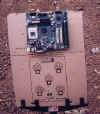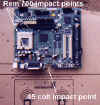
or...
Why NOT to buy an e-Machine (Cybercide pt. II: "The Revenge")
![]()
by John Dunn
Technical Assistance courtesy of AK Church
(Special thanks to Bill Fitchue for invaluable help with the malfunctioning image scanner)
Greetings fellow shooters. Allow me to distract you from the boredom of your hum-drum daily routine with an unusual experiment in ballistics testing you won't find in the pages of a reloading manual or Gun Digest...though I wouldn't be surprised if it was seen in a BATF training manual. I'm sure anyone who's ever owned a computer for any length of time has had to go through the painful, frustrating, and paycheck-depleting agony of being temporarily off-line. You can't get your email! You can't surf Sixgunner! You can't play Solitaire! Or...most wretched of disasters, maddening enough to encourage small arms fire at the unresponsive computer screen (I'm getting to that)...your local electric company makes a decisive effort to annihilate the small computer services company where your personal web sites are hosted! This then results in a catastrophic loss of data for the pages you maintain. All your hard work is gone. When current backups are not to be had at the office, you are left with ruined computer components, such as burned-out backup servers & SCSI drive boards that the city is not about to pay for.
Yes, friends...ever wonder what to do with those old computer parts that cost a semester of college to upgrade or repair, that mock you when they decide to take a permanent lunch break and leave your computer wallowing?
non functional e-Machine motherboard being prepared for "ballistic testing". Note: Click on the thumbnails for a larger image.
Well, short of giving similar treatment to your home's electric meter and having UPS ship it to the aforesaid electric company and winding up in jail, I present the following solution. Sixgunning pro and HTML trail boss Jim Taylor was the recent possessor of a computer known as an "e-Machine" which just killed itself. One fine day, going about his business, Jim switched on the computer. Being as safe and conscientious a computer user as he is a shooter, this system was plugged into a surge-shielding Uninterruptible Power Supply. Nonetheless there was heard a teeth-gritting pop and the computer perished. Upon investigation Jim discovered the power supply had blown a fuse, quite possibly slagging the whole computer. The gentleman asked me if I could fix it.
I had never heard of the "e-machine" brand of computer before but agreed.
It seems that this is a failing common to that model of computer. In my pursuit of a repair I contacted the people that make these things as well as consulted some local parts vendors. What I discovered was that the e-Machine Computer Company is a rather fly-by-night operation, flinging together generic computer parts to create budget desktop systems at low prices for mass sales & quick profit. The power supplies they put in those things have a tendency, I am told, to blow a fuse as this one did and waste the motherboard. The real problem, for Jim was cleverly able to obtain a replacement power supply, is that these systems are of the ATX variety, meaning the motherboard has a circuit that lets it "talk back" to the power supply indicating whether or not it should switch on. It was this one small portion of the board that the power supply had burned out, essentially shooting itself in the foot. At least it didn't wreck the CPU or other components.
I have to thank the folks I called at e-Machine for the hearty laugh they gave me when they quoted the price of a replacement motherboard. I found a much better quality replacement--an Asus--at a local computer store and replaced the board, leaving Mr. Taylor with a working computer.
This of course left us with the dead computer part...
Jim's motherboard set up for lead-impact analysis
As seen in the photo it was discovered that Jim's motherboard could indeed fulfill one last purpose! It was decided that the offending part could serve as a receptacle for a bullet impact analysis.
Jim was gracious enough to let us have the cold stiff computer corpse for our grisly experimentation. We started small. With the assistance of my colleague AK Church we first sought to determine if the board itself could be used to deflect a .22 bullet. Clipping the motherboard to the cardboard backer of my trusty MTM target stand we set it up at the local Conservation Department rifle range, in the 25 yard lane. Multiple shots were then fired from AK's buntline Single Six, and we found one of two things: either we had cleverly shot all around the motherboard, or the substance of the circuit board itself was indeed stalwart enough to withstand a common .22 round. Other than the screw holes where the board is typically affixed to a computer case, no new orifices were found. Being the peerless marksmen we are (and as there are no other witnesses to contradict us) it was assumed we had of course shot through these screw holes.
After this determination was made, the Single Six was set aside and we tried the next "step up" in caliber size and fired a few rounds from both my trusty Makarov pistol and A.K.'s Tokarev. These still did not provide the sought-after "circuit board impact trauma." We kept going, looking for better stopping power so that you, our readers, would have the benefit of our wisdom should you too have need of euthanizing a computer. Thus we attempted to ascertain if the offending computer part could withstand the impact of either a .45 Long Colt round or a Remington 700 (also provided by Mr. A.K).
It could not. The sights on my Winchester 94 were a little off but the trusty factory Silvertip .45 LC round penetrated the target nicely, and Mr. Church was able to destroy both a RAM socket as well as the CPU socket with his Remington as seen in the photo below.
The e-Machine motherboard did impress in one small way; while various transistors and socketry were effectively excised from the board via application of jacketed lead projectiles, the board itself did not crack with each shot. Regardless of caliber or velocity, each bullet punched only a small hole to allow its passage through the circuit board and no more. There was no surrounding "hydrostatic shock" damage as is usually seen in lead-impact situations with other types of computer parts.
Deciding this did not reflect proper disciplining of the wretched thing I asked Mr. Church if he would please attempt a shotgun test. Attaching the short 12-gauge barrel to his superb handi-rifle, we attempted a final ballistics test, with the following satisfactory result:
Pieces of e-Machine motherboard scattered about the backstop
As you can see the result was much better. It was discovered that the e-Machine 366 MHz-rated ATX motherboard was unable to withstand a direct close-range blast from a 12-gauge #6 load. The gruesome remains were collected and are shown below. Note all that remains of the lower DIMM socket is one of the plastic holding clips:
my eyeglasses in upper left for scale
AK and I feel we have performed a fine service for Jim as well as society as a whole. The expensive computer part that threatened to be of no use to him whatsoever did in fact serve a last useful purpose.
Thank you for your attention.
visitors since website crashed AUG 2003

